The Microsoft Surface Pro 4 Review: Raising The Bar
by Brett Howse on October 21, 2015 9:00 AM ESTBattery Life
One of the trade-offs that Microsoft has made with the Surface Pro 4 is a reduction in battery capacity. Ever since the first Surface Pro was launched, Microsoft has equipped it with a 42 Watt-hour battery. That is a large size for a tablet, but the Surface Pro has always been a larger than normal tablet too. With the Surface Pro 4, the battery capacity has been reduced slightly to 39 Wh. Part of this is the thinner chassis, and part of it is the new hybrid cooling which puts a copper plate over the battery. I can’t argue with the new cooling system, since it has clearly made a big difference in thermals.
To take a look at battery life, I’ve run both our tablet battery tests and our notebook battery tests. As with all of our battery life testing, the display is set to 200 nits for a consistent result across devices.
Tablet Battery Life
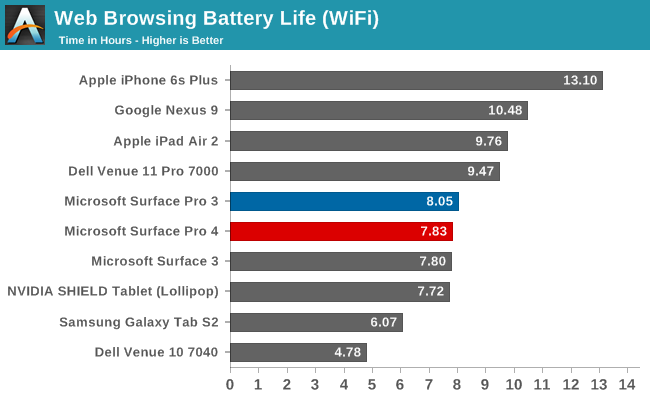
Looking at our tablet web browsing test, the Surface Pro 4 comes in right around the same battery life of the Surface Pro 3, running out of power about 13 minutes sooner. When you think about the move to Skylake, this could be taken as a disappointment, and I honestly thought it might be able to get a bit more. But the smaller battery capacity and increased pixel density both negatively impact batter life despite the CPU using a bit less power itself. I would have loved to see the larger battery stay, which would have given it about 8.5 hours, but the improved cooling system is likely a better trade-off compared to around 30 minutes of battery life.
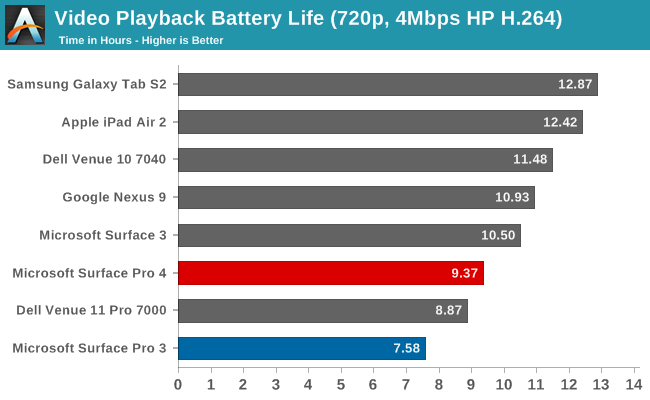
Once we shift to a more CPU-intensive workload however we start seeing significant gains. Intel has been making good progress on their video decode power consumption since Haswell, and the Surface Pro 4, despite the greater pixel density and a smaller battery, achieves 23% longer battery life than the Surface Pro 3 at this task. This is a great result and puts the Surface Pro 4 more in line with what traditional ARM based tablets can achieve.
Notebook Battery Life
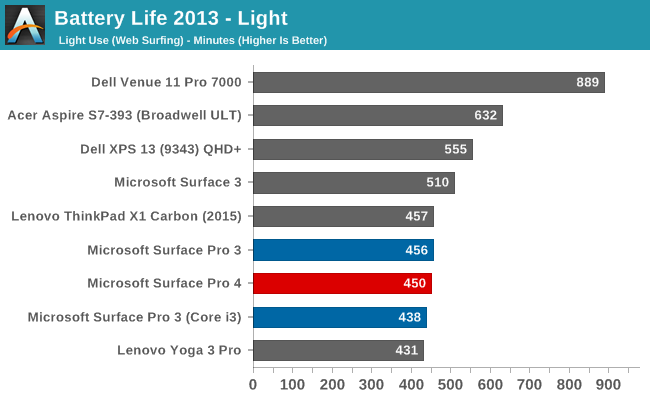
Once again the Surface Pro 4 falls right in line with the previous generations for battery life, which means that the efficiency has been improved even though the panel is much denser. While certainly not class leading in overall life, for the size of device and performance available, it is a pretty good result. Being able to keep battery life flat, while improving the display resolution, and making the device thinner and lighter, is in line with what you would expect as they pack more and more power efficient parts into the Surface Pro 4.
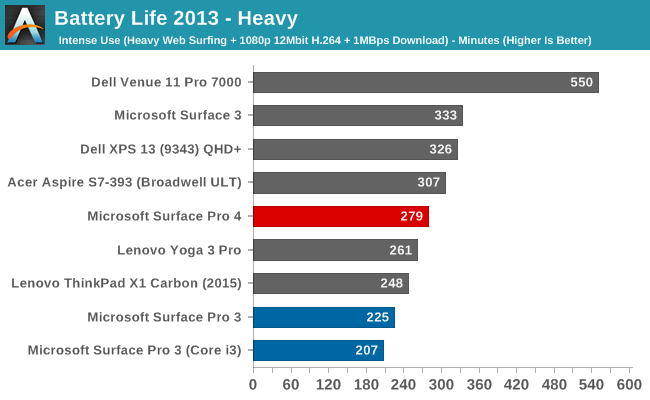
Under our heavy battery life test we can really see the improvements with Skylake. The Surface Pro 4 battery life score on our heavy battery life test outlasts the Surface Pro 3 by 21%. The heavy test involves video playback, which we have just seen in the tablet workload is significantly improved, as well as a much higher web load and a 1 MB/s file download. Once again, the Surface Pro 4 is not going to be able to compete with notebooks with much larger batteries, but for the size and weight of the device, it is a good result.
Next up let’s break down our results by energy efficiency.

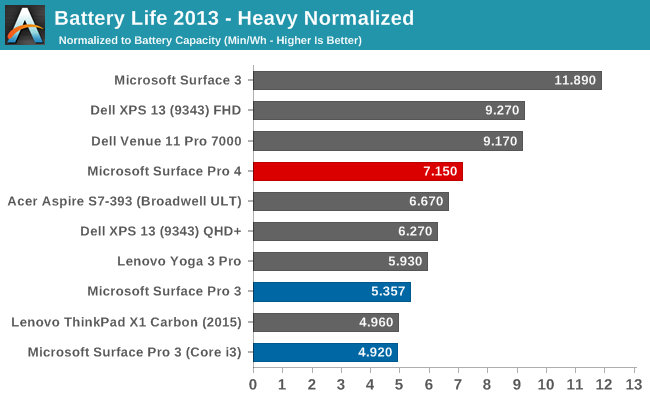
The XPS 13 is the class leader in battery life at the moment, but it achieves this with the 1920x1080 display. In order to be more comparable to the Surface Pro 4, the graph shows the higher resolution 3200x1800 version which was still able to get some pretty good battery life scores. The Surface Pro 4 manages to be more efficient than every other high resolution device we have tested, although lower resolution devices are still able to offer greater overall efficiency.
Charge Time
Microsoft has kept the same charging system from the Surface Pro 3, with the Surface Connect port providing the connection. This hasn’t changed since the last model, but I do like the magnetic connector and how well it always attaches. I kind of wish Microsoft had added a USB-C here as well, but the Surface Connect port is a pretty nice implementation. Unsurprisingly then, the charge time does not change very much at all compared to last year’s model.
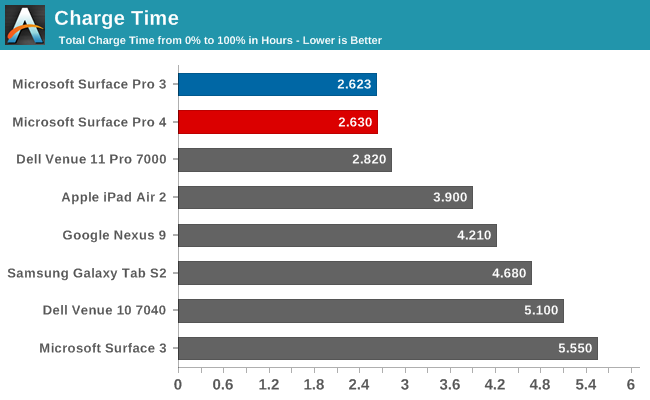
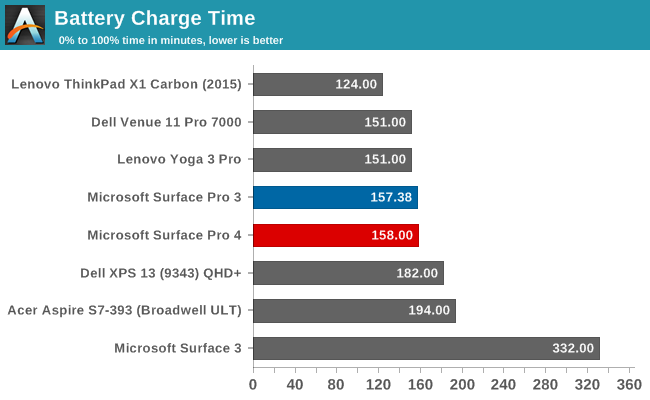
I recorded a 158-minute charge time with the standard charger. Microsoft also offers a higher wattage 60 W version for use with the Surface Book, and you can also purchase it as an accessory for the Surface Pro 4. The result with that charger? 158 minutes. The Surface Pro 4 did not dump any extra power to the battery at all with the higher wattage charger.
Once other nice part of the Surface Pro 4 charger, which also carries over, is the included 5 W USB port on the charger itself, so you can charge up your smartphone without burning two outlets. It’s a small thing, but when you are at a hotel where outlets on the desk are at a premium, it’s nice to be able to do this.


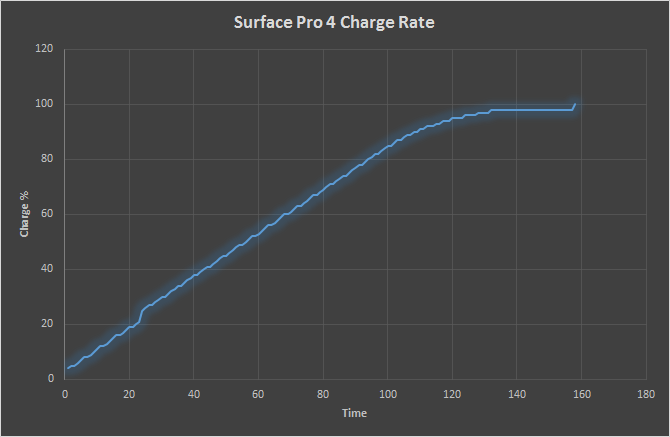








175 Comments
View All Comments
Mushkins - Wednesday, October 21, 2015 - link
"It is a 2x2:2 802.11ac card, and it appears to be the exact same card used on the Surface Pro 3."Great, so it's going to require a restart every other day when your wireless starts transferring slower than dial-up for no apparent reason. If there was *one* piece of hardware they seriously needed to re-evaluate in these great devices, it was the crapola wireless cards they put in them.
Gunbuster - Thursday, October 22, 2015 - link
This! This! So much this. Did someone accidentally buy a billion Avastar chips back in the Surface Pro 1 days? It's incomprehensible.adrians - Thursday, October 22, 2015 - link
I haven't had any issues with my SP3 and two different routers. Please don't assume that it's a widespread problem just because it happens to you and a few others. Think about all the users who have an SP3 and don't complain because everything's fine. Try switching your router. Also try connecting on the 5GHz band instead of the 2.4GHz band (if your router supports dual bands) since the 2.4 band is more prone to interference from microwave ovens, portable phones, remote controlled toys and other devices that operate around that frequency. Even if you don't have these, your neighbors might and could affect your connectivity. Another thing to play with is the channel your router is using. People often leave this on default and this can lead to very bad connectivity when a bunch of routers around you suddenly are more heavily used during peak times. There are apps (both desktop and mobile) you can use to determine the best channel to use at your particular location and at a certain time. If you do use one of these, just make sure that you are comparing the actual band (2.4/5) you will be using with the SP3.Gunbuster - Friday, October 23, 2015 - link
Yes select the band. the single feature they added to the driver at around fix attempt 12.It's a high end device and it derps along on my 5Ghz (after setting it on a separate SSID because it has no clue on dual homed 2.4/5 routers) at 70 something megabit maximum while a 2 year older laptop is jamming out with 200+ megabit transfers. That's best case when it's not loosing connection out of sleep or maxing out at under 10 megabit. (on 1.8 acres with little to no signal bleed from the neighbors) The chip is terrible. stop apologizing for it.
Ngmk - Sunday, October 25, 2015 - link
I was never able to use the 5ghz band in my router with my SP3, the internet was so slow, slower than dialup. I have an Asus 4x4 2400ac. I also experience the same problem at my office with a diferent router.Luc K - Saturday, October 24, 2015 - link
I have 2 SP3's and I never had wifi problems with either one of them on various networks (only used 2.4 so far).Laxaa - Wednesday, October 21, 2015 - link
The "midrange" model(i.e., the one in the review) seem like the one to get. I was originally looking at the i7 model with 8GB RAM and a 256GB SSD because of the better graphics, but I´m not sure if it´s worth the price difference.I´m glad they improved the display and made it more accurate. I work in graphics design so a color accurate display is very important to me.
blueknigh7 - Wednesday, October 21, 2015 - link
Nice Review. I might be looking for something to replace my SPro2Just a quick #correction. The Surface Dock first appeared with the Surface Pro 2 model. It wasn't available at launch, but came out 2 months later or so. I have one. :)
Brett Howse - Thursday, October 22, 2015 - link
Sorry brain cramp there. Updated the text thanks!dafreak - Wednesday, October 21, 2015 - link
What is the implication of having a 'white point' of ~7.3K when the target is ~6.5K while having the other criteria with a dE= ~1.5? Is a recalibration necessary?